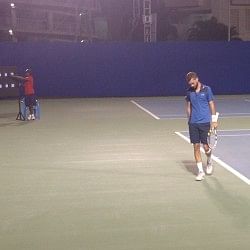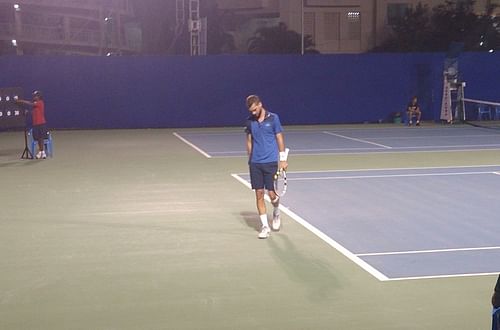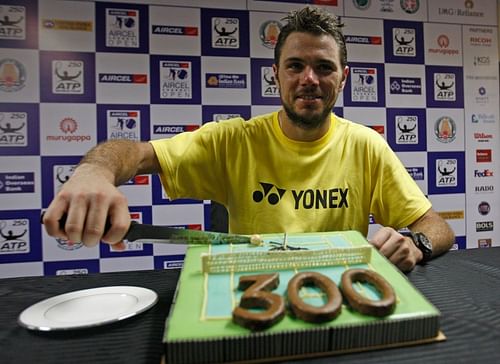
5 things we learned on Day 5 of the Aircel Chennai Open
It was quarterfinals day at the Aircel Chennai Open, and I can’t exactly say whether it was the buzz among the crowd or just a play of my subconscious that made the air in the grounds seem a little more electrifying than usual. After four days of mostly one-sided encounters and relatively unknown names we were at the business end of the tournament, and it showed. Everything had a little extra edge of seriousness to it; even the practice sessions of the players looked a lot more grim and businesslike. But that’s the price that has to be paid to get the kind of ultra-competitive, high quality tennis that you usually associate with the late stages of a tournament, and in that respect, quarterfinals day at the Aircel Chennai Open didn’t disappoint at all.
Without further ado, then, a look at the five most significant take-aways from Day 5:
Chennai can make you sweat…a lot
The heat and humidity of Chennai have been widely documented and lamented by nearly everyone who has ever visited the city. But the start of January, with its relatively lower temperatures and cool breezes, is the least hostile time to hold a tennis tournament. Vasek Pospisil might not necessarily agree with that though. The 23-year-old Canadian simply couldn’t stop sweating during his 6-3, 6-3 victory over Yuki Bhambri, despite the fact that it was he who was making the opponent do all the running, rather than the other way around.
Pospisil’s pace of shot, both on the serve and off the ground, was too hot to handle for Bhambri, who looked remarkably under-powered today after two consecutive matches of holding his own against top players. With Pospisil’s howitzer forehand cannoning all around the court, Bhambri’s own preferred forehand wing looked feeble in comparison, and the Indian never looked likely to make an impression on his opponent.
But that didn’t stop the Canadian from sweating profusely throughout the match. He seemed to require a shirt-change at nearly every changeover, and by the end his chair looked like a messy teenager’s bedside corner, with an avalanche of dirty shirts piled up on it. If Pospisil ever decides to visit Chennai during the summer, will he be in danger of melting?
Benoit Paire’s forehand has a mind of its own

Benoit Paire cuts a forlorn figure as he struggles with his erratic play
Benoit Paire’s quarterfinal against Marcel Granollers started with Paire making a rash of errors off his forehand, and it ended the exact same way. In the middle, the Frenchman found a way to put more air under the shot and prolong the points long enough for his excellent backhand to take over and finish them; that was all that was needed, really, for him to completely dictate the tempo and the direction of the rallies. He lost the first set 6-2 but then came back to win the second 6-3, and was up two breaks at 5-1 in the third.
Unfortunately for him, that ‘good forehand’ period didn’t last long enough to win him the match. With everything seemingly under control and his good friends Stanislas Wawrinka and Edouard Roger-Vasselin (both of whom had already booked their passage into the semis) sauntering on to the side court in anticipation of his victory, Paire’s forehand went off the rails again. He simply couldn’t find the court with it, and Granollers completed an unlikely victory, winning the third set in a tiebreaker, 7-6 (5).
Paire served for the match not once, not twice, but thrice, and each time his forehand decided to betray him. During those ‘bad forehand’ periods, every stroke he hit off that wing seemed rushed and shaky, even the ones that did land in the right spot. I suppose it could be just a confidence thing; Paire’s forehand is definitely not his most natural or preferred groundstroke, and it’s easy to see why it would break down when he’s put under pressure.
But from the vantage point of the stands on Court 1 (side note: it’s a mystery why this match, which looked like a sureshot blockbuster on paper, was scheduled on the side court instead of Centre Court), it really looked like Paire was actively doing battle with his forehand. He even took out his frustration in customary fashion, smashing his racquet to smithereens after a particularly bad phase of play. I imagine he would just love to be able to isolate the part of the racquet which produces his forehand, and pummel the living daylights out of that segment while leaving the rest untouched.
Marcel Granollers is the very definition of a human backboard
Granollers doesn’t own a flamboyant backhand like Paire or Wawrinka, he doesn’t run like a madman the way Rafael Nadal does, and he doesn’t thunder down aces like John Isner. But what he can do is impressive in its own way, even if it is a lot less glamorous.
While Paire was struggling with his soaring highs and dismal lows on the other side of the court, Granollers was immovable, retrieving everything that his more talented shot-maker threw at him. He kept making Paire play the proverbial extra shot, and that kept turning into the Frenchman’s doom. Granollers wasn’t fighting just his opponent, either: the crowd, small as it was, was vocally and vociferously in Paire’s corner. And when Wawrinka and Roger-Vasselin showed up to support Paire, it seemed like the entire arena was conspiring against the Spaniard.
But Garnollers fought them all off and lived to tell the tale, producing one of the more memorable comebacks in recent times to reach the semifinals. Granollers may not be the most visually appealing player around, but no one who watched him battle against Paire and the elements can grudge him his moment in the sun.
Stanislas Wawrinka is officially a superstar

Stanislas Wawrinka, the man of the moment
It’s hard to tell when exactly the transformation process started, but there’s no doubt that it is complete now: Stanislas Wawrinka has well and truly turned from a talented journeyman into a certified superstar. A year ago he was busy making a fool of himself at this very tournament by complaining about line calls and arguing incessantly with the umpire in an ill-tempered quarterfinal loss to Aljaz Bedene. But this year, wearing the tag of tournament favourite with aplomb, he wasted little time in dusting Bedene off at the exact same stage, beating him 6-2, 6-1. And all through the match the crowd couldn’t stop screaming his name; even the fact that it is borderline impossible to say his long, tongue-twisting last name in the form of a chant doesn’t stop people from heartily going at it.
The real indication of Wawrinka’s stardom, however, came during the post-match press conference. By defeating Bedene Wawrinka had notched up the 300th ATP tour match win of his career, and to mark that milestone the Hyatt Regency, one of the sponsors of the tournament, greeted him with a large and sumptuous cake upon his arrival in the press room. The Swiss, who seemingly hasn’t yet gotten used to his newfound popularity, reacted to the tribute with his trademark shyness, but there was no mistaking the significance of the moment. With no local interest players left in the draw, the tournament is, frankly, revolving around Wawrinka now.
There may still be the occasional Roger Federer reference when people talk to Wawrinka, but the man is, for all practical purposes, a star in his own right.
The Chennai crowd knows its tennis
Chennai has long been known as the tennis capital of India, but it is still a little startling to hear people of vastly differing age groups talk about the sport like it is second nature to them. While sitting among the crowd at any match you will get your fair dose of mistimed applauses and unreasonable admonitions, but you will also get to hear informed analytic discussions and technical tidbits about the play.
Middle-aged, sari-clad women comment upon the importance of Marcel Granollers making his first serve, tweens with Justin Bieber haircuts talk about Dudi Sela’s poor break point conversion rate, and a bunch of ‘cool dudes’ with their tattooed arms and faint American accents insist that it’s imperative for Yuki Bhambri to direct every shot at Vasek Pospisil’s backhand (presumably, so that Bhambri can avoid facing the wrath of the Pospisil forehand).
The clincher for me came when, after the wildly see-sawing Paire-Granollers encounter, a homely-looking 60-year-old woman knowingly declared, “Granollers was destined to win the match”.
Can’t argue with that, can you?